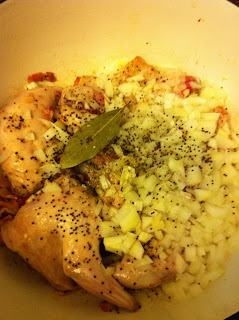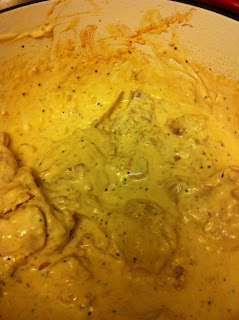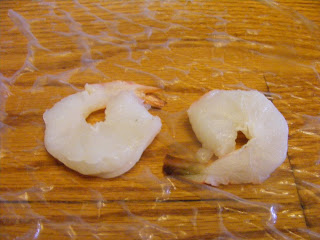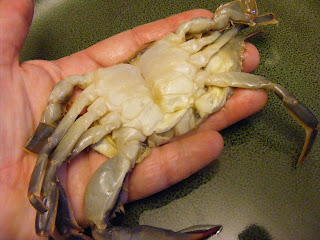I made my favorite food on the planet--beef rendang--a few weeks ago. It's been four or more years since I last made it. It's very rich, so I usually reserve it for special occasions, like someone else's birthday or a New Year's Eve party with friends. Lately, however, I've come to the realization that waiting for rendang is probably not a wise use of the time I have remaining on Earth. Life is short. Time is running out. Seize the day! Make the
rendang!
There are a million different recipes for
rendang, the celebrated Southeast Asian feast food made from meat braised in coconut milk and spices. It amazes me how varied the recipes are and how different the final dish can look--from soupy/sauce-y and bright red to bone dry (a kind of dish known as a "dry curry") and nearly black. Some cooks don't use
lemongrass at all; others omit the ground spices and just heap on the lemongrass and
kaffir lime leaves. Some use a fiery blend of raw and dried chillies; others offer only the tiniest background prick of capsicum heat.
Chicken appears in a number of the online recipes, though I have never tasted chicken rendang and can't imagine chicken meat standing up to the long cooking time. (Maybe a stewing hen would work, but they aren't readily available at most American groceries.) I have tasted lamb rendang and enjoyed it, but for me, rendang means beef or water buffalo . . . or cow.
 |
| Rendang served with plain basmati rice, cucumbers and tomatoes. |
The "beef" used in this particular demonstration of rendang is cow. After hearing about and reading too many real life horror stories about the U.S. corn industry, feed lots, and how cattle are made mortally ill by what we make them eat, I have given up consuming commercially-produced beef. This is not easy; I love beef.
I have no problem with, no guilt about, the fact that animals have to die for me to be a dedicated omnivore. I
do have trouble, however, with the idea that the animal I'm eating was abused and tortured before ending up on my plate. Cruelty is not palatable. Nor is it necessary. As Temple Grandin says, "Nature is cruel, but we don't have to be."
For this day's recipe, I managed to acquire the meat of a retired, grass-fed, free-range dairy cow who was treated well all her life. In celebration of her life and ours, I offer the following:
Happy Cow Rendang
I can't speak to the authenticity of my recipe, since I developed it over a number of years in an information vacuum (this was back in the '80s, before Internet food blogs from around the world) and without easy access to key ingredients. When I lived in eastern Washington, in fact, I had to have one of my sisters ship coconut milk, lemongrass and kaffir lime leaves from her home in San Francisco. My mom would also send me ingredients, when she could find them for herself, from her home near Chicago. My willingness to hassle family members for ingredients, and sacrifice to raise the money for the shipping costs when I was dirt poor, is testimony to my love of this dish.
As I was developing this recipe, all I had to go on was a series of memories--memories of eating rendang at weddings and at neighbors' and friends' homes during
Hari Raya Puasa (the end of the Muslim fasting month of Ramadan) and memories of standing over a steaming kuali (a.k.a. 'wok'), stirring and stirring a rich meat and coconut milk stew under the guidance of our cook in
Kampung Baru when I was all of six or seven.
 |
| Dried red chillis (these are Chile de Arbol) in hot water. I was halfway through snipping these chillis into small pieces with my kitchen shears before I remembered to take a picture, which is why some of the chillis are whole and some are not.) |
- 3 lbs. stewing beef, cubed
- 3 tablespoons peanut or canola oil (or coconut oil, if you can find it)
- large yellow onion, diced
- 2-inches ginger root, peeled and minced
- 8 or so garlic cloves, crushed
- 4 stalks of lemongrass, cut into short segments (if not available in your product section, these are available from online Asian groceries)
- 6-8 kaffir lime leaves (if not available in your product section, these are available from online Asian groceries)
- 2-3 star anise
- 2 sticks cinnamon
- 3 tablespoons ground coriander
- 2 tablespoons ground cumin
- 1/2 teaspoon ground clove
- 1/2 teaspoon ground nutmeg
- 6 dried red chillies (Chile de Arbol, dried Cayenne and Thai chillies are easiest to find in the American midwest), seeds removed, reconstituted in 1/2 cup of boiling water; cut into small pieces. [This made a medium-spicy rendang. Add more if you prefer more heat.]
- 2+ cans unsweetened coconut milk
- 1 cup dessicated coconut, toasted (For me, dessicated coconut has always been the hardest ingredient to find. Do not use the sweet shredded coconut that we use in the U.S. for cookies, cakes and other desserts. What you want here is unsweetened, dried coconut meat with no additives. My supplier is the bulk foods aisle at Whole Foods in Cleveland, about an hour's drive away.)
- salt to taste (DO NOT ADD until after coconut milk has boiled down)

1. In a heavy dutch oven, brown the beef in oil in small batches. Do not crowd the pan, or the meat will steam rather than brown. Set the browned meat aside.
2. Into the hot pan, toss the diced onion, ginger root and garlic. Stir fry until the onion pieces are translucent and soft, about 10 minutes.
3. Add the lemongrass, kaffir lime leaves, star anise, cinnamon sticks, and ground spices. Stir fry another few minutes, until the spices start to release their fragrance.
4. Add the coconut milk and deglaze the pan (that is, scrape all those bits of meat and onion from the bottom of the pan). Add the meat back into the pan, along with the chilli pieces and their water.
5. Bring this beige-ugly stew to a boil, then turn the heat down to very, very low. Cover the pan with a heavy lid and allow to slow stew for at least 2 or 3 hours. You can add more coconut milk, if you need to. As time goes on, an astounding, heavenly aroma will begin to fill your house. [Note: The more authentic way to cook rendang is in an open wok over a low flame, adding more coconut milk as it boils away. However, because coconut milk is expensive and sometimes hard to find in Ohio, I prefer to put a lid on the pot to slow down the evaporation of the coconut milk, at least until the meat is very tender. An added advantage to the closed-pot method is that, in the end, there are fewer calories in the final dish because there is less coconut oil.]
6. Toast the dessicated coconut in a dry pan until deep brown. Be careful. The coconut will not seem to be toasting for quite a while; then, suddenly, it will go golden and brown
fast. I usually turn off the heat when the coconut is golden and allow the residual heat of the pan to finish the toasting.
7. When the beef is very, very tender (or even falling apart), it's time to reduce the braising sauce to a paste. Turn up the heat and keep stirring as the liquid boils away. Stir and stir and stir. It is vitally important to keep stirring, as the thickening concoction will tend to scorch and burn. When most of the liquid is gone, you can add some salt, to taste.
8. As you stir, remove those hard-to-chew aromatics--the lemongrass, lime leaves, cinnamon sticks and star anise pieces. These you can throw away or compost.
9. When the sauce is very, very thick, add the toasted coconut and keep stirring. Eventually, the rendang sauce will start to pull away from the pan and stick to the meat. This means it's done! Turn off the heat.
Makes 12 to 16 servings. Traditionally served over steamed rice or with
roti, Malay flat bread. Fortunately, rendang freezes well, so I will be setting aside a good portion for Ground Hog Day (my birthday).
Below is a one-handed video of steps 6, 7 and 8 combined. (My first cooking video! My apologies for mumbling. I spoke as if I was talking to myself instead of to you, my audience. I'll try to do better next time.)

















































